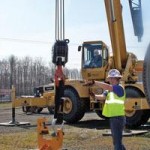5 Must-Knows about Hand Signals and Voice Signals when it comes to Certifications
By: Mike Parnell – The Pro Rigger
When the new construction crane standard goes into effect in the updated OSHA 29CFR1926 this summer (2010), a result of the CDAC efforts, our industry will see the growing demand for Signalpersons who have qualified by written and performance testing (typically through a nationally accredited program). Some key tips that signalperson test candidates want to remember are these:
1. Understand crane operations and limitations. The signaler needs to know what results may occur when certain signals are given to direct a crane operator (especially boom type cranes). Gain or loss of capacity can happen fast and giving a “boom down” signal may put a crane into an overload condition very quickly.
2. Understand special assignments as a signalperson. These may include but not be limited to “blind pick” relay signals, serving as a special assigned signaler during lifts made in the “prohibited zone”, or during lifting activity incorporating a suspended personnel platform.
3. Be able to truly present the hand signals. These are illustrated and explained in ASME B30.5, B30.2 and B30.3. There is a huge movement to “standardize” hand signals between the two most active Signalperson certifying groups CIC and NCCCO. Both groups have built practical exams that require the candidate to be very “exacting” in how the hand signals are given during the testing. These tests are patterned after the ASME signals, and there is almost no allowance given for “old school” or lazy hand signals.
4. Be able to give voice signals in a format as presented in ASME B30.5. During the certification testing, the candidates must adhere to the following format, a) Function and Direction, b) Distance or Speed, c) Function and STOP. Many varieties exist but in order to be successful during the current national exams, the format described should be the basis for written or performance test questions.
5. Understand what to do if there is a failure in the “continuous” communication process. As implied, all signals are to be continuous, whether hand or voice. If an “unplanned event” occurs to the signalperson he should give a “stop” or “emergency stop” until the event can be sorted out and the load moved without incident. Additionally, if the operator cannot see or hear the signals and suspects an “unplanned loss of contact” has occurred he should stop moving the crane and load, until the situation can be rectified. The signalperson needs to know what to do during “unplanned events”.
CAUTION to all Readers! Many “regional” signaling methods variations exist. In order to be successful during the current national exams, the hand and voice format as described in ASME B30.5, B30.2 and B30.3 should be strictly adhered to when completing all of your written and/or performance tests.
An excellent instructional manual for Signalperson exam candidates is available at www.iti.com/bookstore. Request Item #3155 – Student Guide – Signalperson Training Course.
Used with permission from Mike Parnell & Industrial Training International


